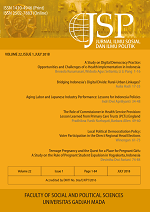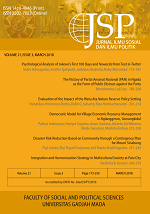Socio-Economic Condition of Communities in Resolving Conflicts in the Bukit Tangkiling Conservation Area
Saptawartono Saptawartono(1*), Kumpiady Widen(2), Hendrik Segah(3), Yanarita Yanarita(4)
(1) Doctoral Program Environmental Sciences, University of Palangka Raya
(2) Faculty of Social and Political Sciences, University of Palangka Raya
(3) Department of Forestry, Faculty of Agriculture, University of Palangka Raya
(4) Department of Forestry, Faculty of Agriculture, University of Palangka Raya
(*) Corresponding Author
Abstract
The Bukit Tangkiling Conservation Area has great potential for natural resources, including clean water, honey bees, recreation services, and religious services. There is also potential for split stone, which had been mined by the people from the rock hills in the area. The potential utilization of these natural resources trigger conflicts between interests to maintain the function and existence of conservation areas with the interests of using split stone for the community in order to meet the development needs of the city of Palangka Raya and its surrounding regions, at the cost of damaging the existing area. As an input in managing the conservation area Bukit Tangkiling is well implemented, research is needed on the social and economic conditions of the community’s surrounding the area. The research used survey methods and respondents are determined by purposive sampling and simple random sampling, and data analysis was both qualitative and quantitative. The communities around the Bukit Tangkiling conservation area are dominated by productive age (18-56 years), Banturung Village 59.00% and Tangkiling Village 54.97%. The level of education is relatively low, Banturung Village 72.96% and Tangkiling Village 73.29%. Having low education, most of the people have difficulty in finding decent work. Aside from that, most people do not understand the function of the forest or the function of the conservation area and tend to be apathetic about the existence of the Bukit Tangkiling conservation area that must be preserved. For some of these poorly educated people, the work of mining rocks is the best alternative to meeting the economic needs of the household. Income obtained from mining rock ranges from 2-4 million IDR per month.
Keywords
Full Text:
PDFReferences
BPS Kalimantan Tengah. (2017). Provinsi Kalimantan Tengah dalam angka Tahun 2017. Palangka Raya. Palangka Raya: BPS Kalimantan Tengah.
BKSDA Kalimantan Tengah. (2017). Laporan pelaksanaan kegiatan pengumpulan data dalam rangka pengusulan evaluasi fungsi kawasan hutan CA/TWA Bukit Tangkiling. Palangka Raya: BKSDA Kalteng.
BKSDA Kalimantan Tengah. (2018). Laporan kegiatan identifikasi hak-hak masyarakat di kawasan CA/TWA Bukit Tangkiling. Palangka Raya: BKSDA Kalteng.
BKSDA Kalimantan Tengah. (2018). Laporan Pengumpulan Data Sosial dan Ekonomi Kelurahan Tangkiling Kota Palangka Raya. Palangka Raya: BKSDA Kalteng.
Basrowi, & Juariyah, S. (2010). Analisis kondisi sosial ekonomi dan tingkat pendidikan masyarakat Desa Srigading, Kecamatan Labuhan Maringgai, Kabupaten Lampung Timur. Jurnal Ekonomi dan Pendidikan, 7(1), 58-81. doi: 10.21831/jep.v7i1.577
Febriana, L., Normelani, E., & Hastuti, K. P. (2016). Identifikasi Kondisi Sosial Ekonomi Penduduk di Kelurahan Kelayan Luar Kecamatan Banjarmasin Tengah. JPG (Jurnal Pendidikan Geografi), 3(2), 42-50. doi: 10.20527/jpg.v3i2.1462
Gubernur Kalimantan Tengah. (2017, November 1). Surat Keputusan Gubernur Kalimantan Tengah Nomor: 37 tahun 2017 tentang Upah Minimum dan Upah Minimum Sektoral Provinsi Tahun 2018 Provinsi Kalimantan Tengah. Palangka Raya: Pemerintah Provinsi Kalimantan Tengah.
Hastanti, B. W., & Triantoro, R. G. N. (2012). Kondisi Sosial Ekonomi dan Budaya Masyarakat Sekitar Kawasan Konservasi: Studi Kasus di Pulau GAG, Raja Ampat, Papua Barat (Social Economic and Culture Conditions of Community Around Conservation Area: Case Study at Gag Island, Raja Ampat, West Papua). Jurnal Penelitian Kehutanan Wallacea, 1(2), 149-164. doi: 10.18330/jwallacea.2012.vol1iss2pp149-164
Kelurahan Banturung. (2016). Profil Kelurahan Banturung. Palangka Raya: Pemerintah Kota Palangka Raya.
Kelurahan Tangkiling. (2016). Profil Kelurahan Tangkiling. Palangka Raya: Pemerintah Kota Palangka Raya.
Menteri Pertanian Republik Indonesia. (1977, 25 January). Keputusan Menteri Pertanian Republik Indonesia Nomor: 46/Kpts/Um/1/1977 tentang Penunjukan Areal Hutan Bukit Tangkiling Dan Sekitarnya Seluas 2.594 ha Yang Terletak di Kotamadya Palangka Raya Sebagai Kawasan Hutan Dengan Fungsi Sebagian Seluas 2.061 ha sebagai Suaka Alam / Cagar Alam dan Sebagian Lagi Seluas 533 ha Sebagai Hutan Wisata / Taman Wisata. Jakarta: Departemen Pertanian Republik Indonesia.
Muflikhati, I., Haryoto., Sumarwan, U., Fahrudin, A., & Puspitawati, H. (2010). Kondisi sosial ekonomi dan tingkat kesejahteraan keluarga: Kasus di wilayah Pesisir Jawa Barat. Jurnal Ilmiah Keluarga dan Konsumen, 3(1), 1-10. doi: 10.24156/jikk.2010.3.1.1
Nanlohy, H., Bambang, A. N., Ambaryanto., & Hutabarat, S. (2014). Analisis Persepsi Masyarakat Terhadap Pengelolaan Kawasan Mangrove Teluk Kotania. Jurnal Wilayah dan Lingkungan, 2(1), 89-98. doi: 10.14710/jwl.2.1.89-98
Pramusita, A., & Sarinastiti, A. N. (2018). Aspek sosial ekonomi masyarakat lokal dalam pengelolaan Desa Wisata Pantai Trisik, Kulonprogo. Jurnal Pariwisata Terapan, 2(1), 14-25. doi: 10.22146/jpt.35378
Senoaji, G. (2011). Kondisi sosial ekonomi masyarakat sekitar hutan lindung bukit daun di Benkulu. Jurnal Sosiohumaniora, 13(1), 1-17. doi: 10.24198/sosiohumaniora.v13i1.5458
Sitompul, M., & Situmorang, R. (2010). Keadaan Sosial Ekonomi di Desa Terpencil Kecamatan Stabat. Jurnal Geografi, 2(2), 81-92. doi: 10.24114/jg.v2i2.6372
Sugiyono. (2017). Metode penelitian kebijakan: Pendekatan kuantitatif, kualitatif, kombinasi, R & D dan penelitian evaluasi. Bandung: Penerbit Alfabeta.
Article Metrics
Refbacks
- There are currently no refbacks.
Copyright (c) 2019 Jurnal Ilmu Sosial dan Ilmu Politik

This work is licensed under a Creative Commons Attribution-NonCommercial-NoDerivatives 4.0 International License.






















